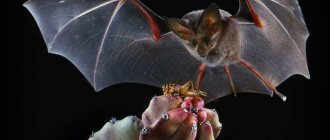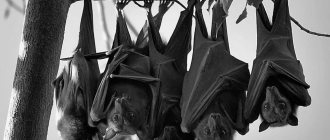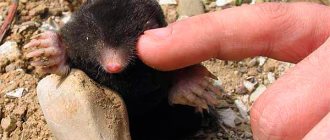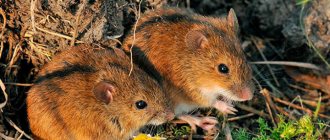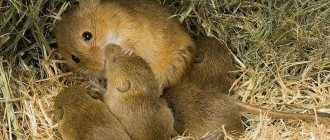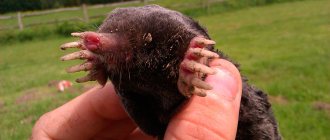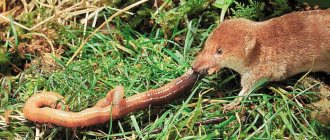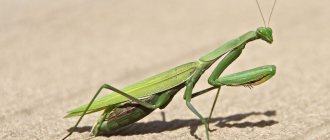Bats belong to the order Chiroptera class of mammals. This is one of the most numerous orders in the biological classification: it unites more than 20 families and about 1,300 species.
The bat is the only flying mammal of all living fauna. The lifestyle of these unusual animals and their repulsive appearance have given rise to many myths and legends. Since ancient times, people have experienced a strong antipathy towards bats, considering them vampires, the embodiment of evil spirits and demons. In fact, bats are harmless and even provide some benefits.
Features of the structure and behavior of bats
The first bats appeared about 60-70 million years ago. Most likely, they originated from arboreal insectivores, which in the process of evolution first formed membranes between their fingers, and then full-fledged wings that allowed them to fly.
The structure of a bat's wing has the following features:
- It is a thin, well-stretchable leathery membrane without feathers;
- during flight, skin tension is regulated by muscle threads located in the membranes;
- flapping is performed using muscles whose weight is less than 10% of the total body weight (in birds this figure reaches 20% or more).
When sleeping or resting, mice can wrap themselves in their wings, thus keeping warm. Just like birds, bats have a keel on the sternum, to which the muscle fibers that control the wings are attached.
In addition to the presence of a flying machine, the features of adaptation to the environment in bats are expressed in the ability to navigate in the dark, camouflage color, the presence of tenacious claws and the production of substances by the salivary glands that reduce sensitivity to bites (in blood-sucking species).
Bats live in colonies. The number of animals in one group varies from several tens to hundreds of thousands or more. Thus, bulldog bats are capable of forming families consisting of millions of individuals.
How to navigate in space
A study of the remains of the extinct ancestors of bats suggests that they first developed wings, and then developed echolocation - a method of orientation in space by capturing high-frequency sound waves reflected from objects. The animal periodically emits sound pulses and, by the speed of their return, determines the presence of obstacles or prey and the distance to them.
Most bats navigate using hearing, but there are species that rely more on vision.
What sounds do bats make?
What does it look like
Bulldog
The appearance of all bats, regardless of species, has the following features:
- thin leathery membranes between the upper and lower limbs;
- the body is small, with shortened humerus and elongated toes on the forelimbs, the tail is usually not covered with hair;
- huge ears with a large number of blood vessels;
- teeth have different shapes, their number depends on diet.
The scientific names of families and genera of bats in most cases indicate the structural features of the skull, the shape of the ears or the front part of the animal’s muzzle: spear-nosed, horseshoe-nosed, pig-nosed, funnel-eared, smooth-nosed.
The coloration of bats is dominated by dark colors: black, brown, gray, brown. Sometimes bats develop albinos. Because their white color is too visible in the dark, they do not survive in the wild.
How many years do they live
In mammals, there is a direct relationship between size and life cycle duration. Taking this into account, bats that are small in weight can be considered real long-livers: their average life expectancy reaches 30-40 years.
Favorite places to settle
Where do bats live? Since they are nocturnal and crepuscular animals, they need a secluded and safe daytime shelter .
Depending on the size and structural features of the limbs, it directly depends on where the bat lives. These animals choose the most suitable ready-made natural shelters for them - caves and rock crevices , depressions in the walls of cliffs and the slopes of dunes, hollows and holes left by their inhabitants.
Some tropical species build improvised umbrella huts from large leaves, gnaw out personal niches in bundles of palm fruits, or climb into the voids between the nodes of bamboo trunks.
Human encroachment into nature is destroying the natural habitats of bats; many of their species are becoming rare and disappearing. However, the bat's adaptability to its habitat is very high and, in the vicinity of people, bats try to discover new shelters for themselves, similar to their favorite caves, burrows, hollows and crevices.
In Egypt, they mastered the internal labyrinths of the great pyramids , in abandoned mines and adits in exhausted mining areas, in cities and villages they inhabit attics, basements, cellars, haystacks, woodpiles, and sneak behind shutters and under window frames.
Information: Representatives of most species prefer to settle in large colonies.
To attract bats in gardens and farms, special houses made of slats with a secluded lower entrance - a narrow slot, similar to inverted mailboxes - are hung on trees at a height of at least 3 meters.
Types of bats: names and photos
Below are descriptions of some varieties of bats.
Pig Nose
The body length of adult individuals is only 3-4 cm. They are found in the southeastern regions of Asia. The front part of the muzzle is flattened and looks like a pig's snout.
Fruity
The second name of the animal is the epaulette fruit bat. Fruit mice live in Africa. They play a large role in the ecosystem of the continent, carrying the seeds of the fruits they eat over considerable distances. This species is known to transmit the Ebola virus.
Water bat
Belongs to the family of smooth-nosed mice. There are no cartilaginous growths on the animal's face. In winter, it goes into suspended animation. Lives in the temperate climate zone. You can distinguish it from its relatives by the reddish tint of its muzzle.
Two-tone leather
vespertilio murinus
Small bats whose range extends over a large area of Europe and Asia.
Brown long-eared bat
You can identify the animal by its very large ears: their length is equal to the length of the forearms. Before going to bed, the long-eared long-eared bat folds its ears on its back and covers them with its wings.
The sizes and weights of some representatives of the order are given below.
| Type name | Body length, cm | Weight, g |
| Maned Acerodon | 29 | 1200 |
| Spectacled flying fox | 24 | 800 |
| Egyptian flying dog | 17 | 400 |
| Great harelip | 13 | 80 |
| Great Spearman | 10 | 80 |
| Wide-eared folded lip | 9 | 50 |
| White leaf-nosed bat | 4 | 7 |
Horseshoe
Adaptation to the characteristics of the environment
Chiroptera creatures demonstrate amazing adaptability to the most extreme temperature conditions. They can withstand both an increase in body temperature up to 40 degrees and a decrease to zero.
The feeding methods of winged animals are also very diverse and correspond to the environment in which they live and reproduce.
The main contrasts occur in the tropical zone, where some species consume purely vegetarian flower nectar and fruit pulp, while others consume the blood of larger mammals. However, the majority of bats prefer to hunt insects . In rare cases, small vertebrates such as frogs and songbirds become their prey.
REFERENCE . The benefits that bats bring to farm crops were clearly demonstrated by an experiment conducted in the USA: a part of a corn field covered with a net, over which night flyers could not hunt, suffered 56% more damage from the caterpillars of pest butterflies.
In the middle zone, bats hunt insects in large numbers . During the night, one animal destroys up to a thousand mosquitoes, as well as numerous pests of fields, gardens and vegetable gardens, whose flight occurs at night.
With the approach of cold weather and the disappearance of their main food, bats look for a winter shelter , the temperature in which should not fall below 0ºC, and fall into suspended animation.
So these amazing creatures survive an unfavorable season in the environment to which they have managed to adapt perfectly.
Awakening comes in the spring , when the first flying insects appear - and the tireless flyers again go out on night watch.
Mass destruction of insect pests in the dark, when birds are inactive, brings undoubted benefits to gardening and farms. If you provide bats with suitable shelter houses, the winged animals will take up residence in them and will work properly instead of insecticides.
Bats often become unwanted neighbors of humans, settling in the attics and balconies of houses and apartments. Some people do not consider it necessary to kick out guests, but such a neighborhood has more disadvantages than advantages. If you decide to get rid of them, do not forget that some of their species are listed in the Red Book and their destruction is prohibited. Therefore, be patient and achieve the peaceful relocation of bats to more suitable places for them.
How do they reproduce?
Due to the secretive lifestyle of bats, scientists were only able to collect general information about their reproduction.
Bats living in warm latitudes are more fertile, as they bear offspring twice a year. Bats that live in temperate climates mate only once a year before going into hibernation. In such subspecies, embryo development is delayed. The duration of pregnancy largely depends on the ambient temperature. At a time, a bat brings from one to three babies.
How they are born
Baby bats are born with their hind legs first, which is very rare for mammals. Before giving birth, the female turns her head up until the baby emerges. Once born, the baby spends a week in the mother's tail pouch. Then the female looks for shelter and hides the brood there, periodically flying up and feeding the children with milk. A baby bat becomes independent within a month.
Ways to drive away animals
Regardless of whether you are faced with a single uninvited guest or are trying to conquer your own attic from bats, do not forget that these animals can be listed in the Red Book. Therefore, chemical or folk poisons have no place here. You must create such conditions so that the “guests” fly out of the apartment on their own.
Random guest
If you encounter a flying animal in your room, do not panic. The random guest is very confused herself. Finding herself in an unfamiliar environment, she will try to find a way out. And you need to help her a little. Follow three steps to remove a bat from your home.
- Clear the room. Remove children and pets from the room.
- Leave the room. Close the door behind you, and you can safely return in five to ten minutes. The bat will fly out during this time.
Open the window. Turn on bright lights in the room, pull back the curtains and open the windows wide.
Don't try to drive the bat away by waving a towel. This action can injure the animal. In addition, the movements can seriously anger the guest, and she will attack you.
Fighting a massive invasion
If you are dealing not with one individual, but with an entire colony, then you need to act differently. Only the “tenants” need to be evicted closer to autumn, when the females feed all the young. If you drive out mice in the summer, you will doom the kids to a painful death, and turn your balcony or attic into a real breeding ground for infection. Therefore, put up with rustling and squeaking at night. Get into the fight this fall with these four steps.
- Surveillance. At night, carefully monitor through which cracks and loopholes the bats get out.
- Examination. When the entire flock leaves the home, carefully inspect the room again so that not a single animal remains in it.
- Repair. Now carefully seal all holes, cracks, loopholes using fiberglass, metal gratings, and sealants.
- Cleaning. Complete the procedure with general cleaning of the room using white, Domestos.
Don't forget about the dangers of excrement. Carry out the expulsion procedure in overalls, a respirator, and be sure to wear thick gloves on your hands.
Repellents
If the expulsion procedure does not end in victory, pay attention to numerous methods that can scare away uninvited guests. They allow you to get rid of bats forever, but do not harm endangered animals. Four drugs are most effective.
- Naphthalene. You can drive out mice using mothballs. Place the substance in bags and hang it in different places. The specific smell will completely repel the animals. It is necessary to change naphthalene periodically. It works as long as it continues to smell. Despite its high efficiency, the method can only be used in non-residential premises. Naphthalene vapors are dangerous to humans and pets.
- Water. A simple way to get rid of mice is to take a shower. Point the hose at surfaces that attract “guests” and spray them with cold water. This will get rid of bats, but, unfortunately, not forever. The animals will calmly return to their places as soon as you dry out the garage or shed.
- Aerosol 876 4-Pack Bat Repellent. If you prefer to fight with industrial means, then pay attention to this drug. It contains peppermint oil. When working with the spray, you must take special care so that, along with repelling mice, you do not provoke intoxication in yourself or your pets.
- Ultrasonic repeller. This is another method that allows you to drive away bats without harming them. Such devices emit special signals that humans cannot hear. But this sound is perfectly captured by the “guests”. They cannot put up with such discomfort, so they quickly leave your walls.
There are other, less effective methods. For example, a smoker. But be prepared for the fact that you will have to smoke for at least three to four days. Mice are afraid of light and fans. But you are unlikely to like this procedure. A roaring fan and a bright spotlight are not at all conducive to good sleep. And the amount charged for electricity consumption is unlikely to please anyone.
Source
Where do they spend the winter?
In the winter months, when there is a complete lack of food supply, some bats migrate south, and the majority fall into a state of suspended animation (evening bats, bats, bats, bats).
During hibernation, the bat's body temperature drops to 1-3 degrees, and the heartbeat and breathing slow down significantly.
Before wintering, mice accumulate fat, which accumulates in the upper back. They look for shelter in caves, tree hollows, and under the roofs of houses. The time at which bats hibernate depends on the region and climate conditions. The duration of hibernation ranges from 3 to 8 months.
Description
Many people don't know whether a bat is a bird or an animal. Chiropterans have wings and can fly, but bats are representatives of the animal world. This mouse is the only animal on the planet that moves through the air with the help of wings. Central America became their birthplace. These animals do not tolerate cold well, so they prefer the mild climate of Asia or the territory of the Primorsky Territory. The animal belongs to the order of placental mammals, the species Chiroptera. Let's look at what a bat looks like.
They differ from each other in appearance and size. The common body size is from 3 to 10 cm, but there are also special individuals - false vampires. Their size is 40-50 cm, and their weight is up to 200 grams. The bat's coat is thick and soft. It is usually gray, black or brown in color. There are animals with a yellowish or orange color. Such a bright fur color is characteristic of the Mexican fish-eating mouse.
The Honduran bat has white fur and yellow nose and ears. There is no fur on the wings. The muzzle resembles a pig's snout with mouse-like elements. There are individuals whose bodies have no fur coat at all. There are such representatives in the Philippines and Southeast Asia.
Bats have different internal structures of the skull and teeth. The long-tongued leaf-nosed bat has a long tongue with which it collects nectar. The elongated shape of the head is needed to accommodate the tongue.
Bats have a heterodont dental system, so they have canines, incisors, molars and molars. Stronger and longer teeth are usually found in animals that feed on thick-shelled insects.
The number of teeth varies among different species of bats. For example, vampires have only 20 of them, while small mice can have up to 38. Vampires have sharp fangs to make bites that draw blood. Fruit-eating bats have teeth similar to the main part of a flower, involved in the formation of the fruit.
Most representatives have a horn on their nose, reminiscent of a rhinoceros nose, and on their heads are large ears, similar to those of a hare. The auditory organ improves the mammal's echo sounding. The bat skeleton has several features. The forelimbs are of an unusual shape, one finger of which has a curved shape with a sharp end. The “hands” start from the hind limbs, reach the forearm and become elongated fingers. It turns out to be a kind of frame, covered with a dense membrane of skin.
The membrane serves as a wing for its owner. In cold times, the mouse wraps itself in its membrane like a cape. Bats are superior in mobility and aerodynamics to birds and insects. The flight speed of bats is from 10 to 50 km/h. Among the entire variety of mice, the Brazilian folded lip reaches the highest speed of up to 160 km/h. The membrane is greatly stretched, approximately 4 times, without being damaged. During flight, the bat makes synchronous movements with its wings, pressing them tightly towards itself, thereby improving aerodynamics.
These mammals have very flexible wings, which allows them to turn 180 degrees without making a turn. A bat can hover in the air like an insect.
It is known that bats cannot see well, but they have excellent hearing. Many breeds of mice have tragus on their ears, which improves and enhances the perception of sounds. False horseshoe bats can detect the rustling of insects under grass or among foliage. Images for them appear in black and white. Echolocation helps them navigate in the dark. Ultrasonic impulses save you from collisions with possible obstacles. However, bats are not completely blind; some see well and can catch prey using their eyes.
A well-developed sense of smell helps to find their cubs after a night hunt, identify a stranger in a colony, or find sources of food.
What do bats eat in the wild?
The vast majority of species rely on insects as their main diet. Some large species of carnivorous bats eat lizards, small rodents and amphibians.
The order also includes herbivorous species (for example, the Malayan short-nosed fruit bat), feeding on the fruits of fruit trees, nectar and pollen.
Representatives of the genus of harelips feed on fish. While hunting, they fly over the pond and catch fry, frogs and crustaceans swimming to the surface.
Of the variety of bats, only three species are blood-sucking: the common vampire, the white-winged vampire and the bushy-footed vampire.
Some representatives of the order (for example, the white-bellied arrowhead) can feed on carrion.
TURTLE
Origin of the species and description
Photo: Bat
Bats are primarily amazing because they move through the air by flapping their wings like birds. However, they do this exclusively at night, without using one of the main senses - vision. They, of course, are not birds, because they themselves are viviparous and feed their young with milk. And they have nothing in common with birds, except the ability to fly, even feathers.
Video: Bat
Bats belong to the class of mammals in the order Chiroptera. There are a huge number of types. According to various sources, there are from 600 to 1000 species of bats. Of course, it is impossible to consider each species separately without being an expert on these animals.
The main types, the most common and having obvious differences, can be counted on one hand, namely:
- two-tone leather;
- giant noctule;
- white leaf-nosed plant;
- pig-nosed bat;
- great harelip;
- water bat;
- brown long-eared bat;
- dwarf pipistrelle;
- ordinary vampire;
- white-winged vampire;
- hairy vampire.
It is believed that the first bats appeared about 70 million years ago, when small arboreal mammals began to develop membranes on their sides, which later evolved into wings. It is possible that the formation of membranes was caused by a gene mutation. Scientists believe that the change in the body structure of animals occurred quite quickly, since to date not a single individual of the transitional species has been found. That is, the so-called high-speed evolution occurred.
Who eats bats in nature
The natural enemies of bats are birds of prey (owls, golden eagles, falcons), snakes, cats, and members of the mustelid family (weasels, ferrets, martens). Ectoparasites pose a danger to bats. If there is a severe infestation of fleas or ticks, the animal may die.
Spectacled flying fox
Despite the large number of natural enemies, the greatest damage to the population is caused by human activity. According to environmental organizations, the numbers of some bat species have dropped to alarmingly low levels. These include the common longwing, the lesser lop-eared pipistrelle and some others. Most species of bats are listed as vulnerable in the International Red Book. At the same time, not only animals, but also their habitats are taken under protection.
Where and how long do bats live?
The mammal inhabited almost the entire planet, with the exception of tundra areas and lands covered with ice. The animal easily adapts to natural conditions, so it can live almost anywhere.
Chiropterans love places where there is no daylight. Mammals live in caves, basements, abandoned places, and tree hollows. There are amazing individuals that wrap themselves in banana leaves. Other representatives may live under bird nests, in bamboo stems, or even in spider webs.
They live on average 5 years, but there are also centenarians whose age reaches 20 years. The record age for bats is 33 years.
At home, mice can live less than expected due to their inactive lifestyle.
Why do bats sleep upside down?
Maned Acerodon
When completing their flight, bats cling to branches or ledges on rocks and hang upside down. The need to take this position during rest and sleep is caused by the structural features of the skeleton: thin bones of the limbs do not allow bats to maintain their body weight on horizontal surfaces for a long time and push off from them during takeoff. When a mouse hangs, it only needs to unclench its claws and begin to fall, while simultaneously spreading its wings.
Bat researcher Oleg Shapkin: “Bats can live more than 40 years”
Oleg Shapkin is a chiropterologist, the only bat specialist in the Darwin Nature Reserve. The scientist told cherinfo whether it is true that bats drink blood, where they go in winter and why these cute representatives of darkness are so poorly studied.
— Oleg, are there many bats in our area?
— There are many more of them near settlements than in the deep forest. These are common animals, even for our latitudes, despite our northern location and cold. Only nine species live here, but they are found often and almost everywhere. It is difficult to even estimate the number of bats in a reserve or region. No one has studied bats in the Vologda region. Experts came to the Darwin Nature Reserve in the 2000s and caught them, but that was a long time ago, and there is not enough information to estimate the number. Most of the bats are listed in the Red Book, but their status there is “no information.”
— Do any special Vologda mice live in our region?
- No, we have a widespread type - two-tone leather. They live with humans, most often living in village houses, but they can also live in cities, as long as there is shelter.
- A place to hang in the dark like a vampire?
“They cling with their hind legs and hang upside down; this is the standard position for them when resting and sleeping.
— Are there bats that live separately from humans?
— There are species that live in forests. We don’t have caves, so they take refuge in the hollows of trees. These are various noctules and the rufous noctule. This species is also common in our latitudes.
- Do they feed on insects or does someone still drink blood?
- Only three out of one and a half thousand species of bats can feed on blood. All these species live in South America. All bats in Russia feed on insects. Our bats weigh from five to 30 grams, and they can eat another third of their weight in the evening. Sometimes I caught nocturnal fish weighing 40-50 grams. They return to normal weight by the next evening, when they have digested everything. Their digestion is fast, they hunt almost every day, weather permitting.
- They hunt at night, right?
- At night, at dusk. The greatest activity occurs within half an hour after sunset and then for two to three hours. Then they return to the shelter. Sometimes they fly out before dawn. Bats have a good ultrasound machine. They emit ultrasound and catch the reflected signal with their large ears. Thanks to this, they “see” insects and surfaces in the dark. Ultrasound helps them communicate with each other. Sometimes you can see how two bats cut circles in the air, as if in a dance, actively squeaking. This is not hunting behavior, this is how they communicate.
“I recently read an article that claimed that bats coo with their babies. That is, they consciously change the timbre of their voice and intonation, as a person does when communicating with small children. Is it so?
— I haven’t seen this article, but in many animals the set of signals for communication with offspring differs from signals for communication with adults. Bats are social creatures, so it's entirely possible. We hear only a certain range of sounds, limited to a frequency of about 20 kilohertz. And among bats the spread is much greater. We hear only part of the sounds they make. At the same time, different bats communicate at different frequencies. If they were alone, the competition would be too high. Rufous noctules, for example, speak at the level of human audibility, in the region of 20-30 kilohertz, and night bats make sounds in the region of 60-80 kilohertz. The rest occupied frequencies somewhere in between.
— How do you record such high-pitched sounds?
— I have a device that converts ultrasound into audible frequencies. This way I can understand what types of bats are flying around. But determination by ear is not very reliable. Computer sound processing is needed, and for this you need to record them with a good microphone and process them on powerful equipment. I don't have one yet.
—Where do bats go in winter?
Bats gain 20% of their body weight in the fall to go into hibernation.
- They are like birds. If we use unofficial terminology, there are nomadic and migratory species. Migratory ones fly far to the south, to the Crimea, the Caucasus, and Spain, while nomadic ones move nearby to more suitable conditions, where there is food and shelter. All our species fly away and simply hibernate for the winter, which lasts two to three months. During hibernation, they slow down their breathing and metabolism, and lower their body temperature. To survive hibernation, they must accumulate enough fat, otherwise they will not survive to warm weather.
— Have our bats already flown south?
— The main part flew away, but some still remained. They do not have a specific time when everyone gets up on the wing at once and flies away. It’s hard to say whether they fly away in families, groups or one at a time. There is an assumption that the adults fly out first and make loud noises, and then the young ones join them. Not to say that these are direct packs, but there is an organization in such groups.
— Do I understand correctly that studying bats gives rise to even more questions about bats?
— This group has been poorly studied due to its nocturnal lifestyle.
— How long do bats live?
—Bats live a very long time for their size. In nature, a life expectancy of 41-42 years has been recorded. This does not fit into the system according to which the smaller the animal, the less it lives. Perhaps this is influenced by their annual hibernation.
- Why do they have such strange noses?
— Our bats have fairly ordinary noses. However, there are species that have noses with unusually shaped projections. Typically, they use their noses to extract ultrasound.
Only three out of one and a half thousand species of bats can feed on blood.
— I heard that bats carry diseases, including rabies. Isn’t it dangerous to study them or is it enough just not to eat them?
“It’s strange to me that you can eat them at all.” Yes, in our latitudes, bats can carry rabies, and you can become infected with it. But the likelihood of this is so small that it is easier to catch rabies from a cat, dog or fox. Over 20 years, there were only about five such cases in Russia. Various viruses can circulate within populations. The most common disease in America is white-nose syndrome. This fungal disease, leading to the death of bats, wipes out entire populations.
— Is there a threat to bats in our latitudes?
“In our country, they rather die of natural causes.” For example, there simply aren’t enough fat reserves for hibernation. Owls pose a slight threat, but they do not specifically hunt bats; mice are too maneuverable.
— There are a lot of memes that play off vampires and bats. Do you feel differently about them after studying bats?
- These are good old memes, but I like them because they play up my charges.
— How did you become a chiropterologist?
— I started studying bats about four years ago, but became interested in the topic in the eighth grade, on an excursion to the Darwin Nature Reserve. Then I got the idea to work in the reserve and study bats. I entered St. Petersburg State University at the Faculty of Biology, for my specialization I chose the Department of Vertebrate Zoology, and for my diploma I began studying bats of the Darwin Nature Reserve. I studied the technique in the Zhigulevsky Nature Reserve in the Samara region. There I learned how to catch mice, how to hold them in my hands, how to weigh and ring them, and how to operate an ultrasonic detector. Now I work in the Darwin Nature Reserve and am studying for a master's degree.
— How many bats have you ringed?
— About 500. But in order to track their movements, their lifetime, they will need to be caught again. We hang the ring not on the paw, like a bird, but on the forearm. And this is not a closed ring, so as not to damage the wing. You can't put a GPS tracker on a mouse - it's too heavy. It is believed that the tracker should be no heavier than 3-5% of the mass of the flying animal. I ring mice with the expectation that I will catch them again. But the likelihood of this is low, because the territory is very large, there are few specialists, and there is no program for tracking mice.
— What to do if you find an exhausted bat?
— You need to take the animal from the street into a warm place, give it water, then contact a specialist who will take the animal. You can contact specialists through the Darwin Nature Reserve group. There were such cases in Cherepovets. In August, we picked up a weakened bat in the Zasheksninsky district near a shopping center.
Semyon Manuilov
Benefits for nature and people
The high rate of metabolic processes in the body of bats forces them to eat large amounts of food. These animals, together with birds, restrain the growth of the number of insects, including pests. Herbivorous bats that feed on nectar provide benefits by pollinating plants. Mice saliva is used for medicinal purposes, and droppings are used as organic fertilizer.
FLYING SQUIRREL
Ushan
The name says it all: these mice have large locator ears. When the animals sleep, they hide them under their wings. The wings are short and wide, thanks to which the animal flutters and can even hover for a short time. The sizes are small – 5-6 cm.
The habitat is extensive: from the Atlantic coast to the Pacific, northern Asian territories, North Africa. The diet consists of butterflies, mosquitoes, beetles and other nocturnal insects. The offspring is 1, less often 2 cubs per year.
Interesting facts about bats
- On the last weekend of summer, bat night is held in many countries around the world. The organizers of the event are usually environmental organizations and activists who are not indifferent to the problem of reducing the number of bats. The main goal of International Bat Day is to familiarize people with the behavioral characteristics of these animals.
- Bat droppings (guano) contain about 9% nitrogen and 13% phosphorus. This is one of the best organic fertilizers. Guano is also used as a raw material in the production of gunpowder and TNT.
- Most species of bats are capable of flying at speeds of about 100 km/h. The fastest animal in the world today is the Brazilian folded lip. Its maximum flight speed reaches 150-160 km/h.
- The largest bat in the world is the Kalong. The animal, which lives in southeast Asia, can weigh up to 1.2 kg, with a maximum wingspan of 1.5 m.
- Bat is the second name of the passionflower coriacea plant. It appeared due to the great similarity of the shape of passionflower leaves with the wings of an animal open during flight.
Maximum bat size and weight
A distinctive feature is its relatively small size. The smallest representative can weigh only 2 g, and the body length is 3 cm. The largest individual reaches a wingspan of up to 75 cm, but its weight is only 200 g. The wings have a membranous structure, and are very thin.
Chiropterans have teeth, since they belong to the order of predators, and have fangs, incisors, and molars. They need teeth to chew insects and small animals. They are distinguished by large ears; this is not a structural feature at all, but a way to recognize the terrain.
Cute creature
